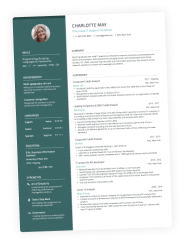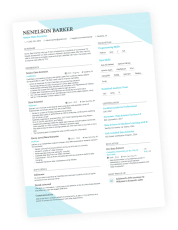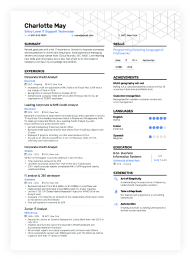Recruiters now see nearly 50 applications on average for every job opening. If you want to stand out—and you really do—you’ll need more than just the usual mix of skills and experience. The truth is, many applicants have similar backgrounds. What sets you apart is how you’ve gone beyond the basics—like learning something new and relevant.
Enter courses, training, and certifications. These extras could be the difference between a recruiter saying “pass,” and them picking up the phone to call you. So long as your training is relevant, up to date, and has offered you real workplace skills, it may be worth adding to your CV pronto.
However, many people simply don’t know how to put training courses on their CV. If you’re stuck scratching your head and have no clue where to begin, we’ve got you covered.
In this guide, we’ll help you decide which courses to include on your CV, show you strong examples, and walk you through how to format them.

Key takeaways
- Relevant training can help your CV stand out in a crowded job market.
- Only include courses that are up to date and tied to the role you want.
- Show how you’ve used the skills from your training in real work, not just that you took the course.
- If a job ad mentions a specific course or certification, pop it on your CV—just make sure you actually have it.
- Place your training where it fits best—under skills, education, experience, or in its own section.
- Be specific, use real provider names, and don’t exaggerate what the course involved.
Is your CV hitting the mark? Finding out is easier than you think. Just upload yours and Enhancv’s CV checker will do the rest:
Is your CV good enough?
Drop your CV here or choose a file. PDF & DOCX only. Max 2MB file size.
Whether you’ve taken hundreds of courses or attended the odd seminar, the first step is understanding what’s worth including on your CV.
Let’s take a look.
What makes a course worth adding to a CV?
Every space on your CV is valuable. Don’t make the mistake of cramming it with irrelevant or outdated information. Before you whack a certificate on your next application, you’ll need to make sure that it’s adding real value.
To help you do this, start by thinking like a recruiter.

Quick starter checklist
First up, ask yourself the following questions:
- What does this training, certificate, or course tell them about me?
- Is the training relevant to the role at hand? (If not, leave it out!)
- Did the training teach me skills I’ll use in this role specifically?
- Is the certificate from a reputable or big-name brand?
Going through the above checklist should help you get clear on whether the course is relevant. But now, we can take a deeper dive into the times you should list training on your CV.
You learnt a rare or future-forward skill
Can you keep up with the quickly changing working world? Whether it’s AI making a splash (in every sector), or new workflow processes trending, it’s your job to stay ahead of the curve.
If you’ve taken a course in either a rare or future-proof skill, now’s the time to shout about it. These talents are certain to become highly valuable in the years to come and will stand out to recruiters.
Think something like an AI course you finished back in 2018, before ChatGPT was even invented.
You’ve used that skill in your work
So, you’ve got a list of certificates as long as your arm. That’s great. But how have you used the skills you picked up in your training? Showing that you’ve applied your new talents is worth its weight in gold.
The value of a course depends on what it solves. If it gave you a skill you used in a project, a client win or something real, add it. If it is sitting in your inbox untouched since 2021, skip it. The line between a useful course and wasted space is whether it helped you do better work.
Where possible, add some much-needed context to your training. For example, you might choose to expand on it in your work experience section, beneath the job you’ve used it in.
Contextualising training in the work experience bullet points
Marketing Assistant
Green & Co. | March 2022 – Present
- Planned and scheduled multi-channel campaigns across email, social media and paid ads.
- Used insights from the Google Digital Marketing Certificate to improve campaign targeting and audience segmentation, leading to a 15% increase in campaign engagement.
- Introduced A/B testing processes, leading to a 17% increase in email click-through rates.
- Reported monthly on campaign performance using Google Analytics.
Casually mentioning a course or certificate, like we have in the example above, can drive home its value. Think about where you can do this as naturally as possible on your CV.
It relates directly to the job description
You likely already know the importance of tailoring your CV to the job description. Make sure you read the criteria closely. Sometimes, the recruiter will specify courses they expect to see from applicants.
It’s not merely about ticking boxes. Including these courses on your CV shows that you paid close attention to the original advert, and that you have a high level of attention to detail.
Like when the posting says, “Project Management Certification required”, and you’ve got one from a legit source.
It fills a gap in your work history or formal education
Gaps in either your work history or formal education happen, and they’re not quite the disaster you think they are. One of the simplest ways you can make up for them is by bolstering your CV with other high-value feats. That’s where adding quality training to your CV comes in handy.
It’s from a known and credible source
Big names can make a pretty major impact. If you’re looking to get the recruiter’s attention, adding a well-known institute or brand into the mix is the way to go.
However, you need to make sure you don’t mislead the reader—purposely or otherwise. Leading them to believe you studied at a top university when you only took a day course, for example, is a bad move. Remember, nobody likes to feel that they’ve been tricked, least of all recruiters.
Listing every course under the sun can actually weaken your profile. It’s kind of like name-dropping Harvard Business School... then people scroll down and see it was a two-day seminar. Impressive? Maybe. Authentic? Not so much.
So, does your training deserve a coveted place on your CV? Use the golden rule: If it adds value to your application, add it onto the page. If not, don’t waste that space.
Now, let’s look at the different types of courses, and why the definitions matter.
Training courses vs. coursework vs. certifications: what’s the difference?
Training courses, coursework, and certifications: Many people use these terms interchangeably, but on your CV, they each belong in different places. Understanding that will help you to be more strategic with your CV space. It means you can place each credential where it will most likely make the biggest impact.
If there is an expiration date, a pass/fail threshold or a recognised provider behind it, it is a certificate. Training is usually more informal or internal. Both matter, but recruiters weigh them differently. Context still matters.
Here’s how to tell them apart:
Training courses
Training courses are short bursts of learning, either online or in person, that usually don’t come with a formal qualification. They're useful and teach you an actionable skill. Examples include webinars, internal workshops, and LinkedIn Learning modules.
Unlike traditional courses, they won't earn you any letters after your name, but they can give you practical skills you actually use at work. Just don’t mistake a half-day Zoom session for a professional certificate.
If you decide to list these on your application, be clear about exactly what they entailed.

PRO TIP
Looking to upskill? There are plenty of places you can get the hands-on training you need. Here are some of the most trusted providers:
- Google Digital Garage: Offers free online courses in digital marketing, tech, and career development, and more.
- FutureLearn: Online training provider offering courses from UK universities and institutions, plus some backed by the civil service.
- HubSpot Academy: A platform with a whole bunch of free marketing, sales, and CRM training you can learn to bolster your skill-set.
- Codeacademy: Looking to learn how to code? Here’s an online provider offering interactive coding lessons and tech skills.
Coursework
Coursework is a little different. It covers the projects or extended work you tackled during school or university. It’s things like modules, essays, research projects or group work. Mention it if you’re just starting out or applying for something closely linked to your degree.
Of course, you should only slide this onto your CV if it aligns with the job and demonstrates a skill that’s applicable to it. You can list this under the relevant part in your education section of your CV.
Adding coursework to your education
BA (Hons) English Literature
University of Leeds | 2018 – 2021
- Coursework: Modernism and the Novel
- Dissertation: “Narrative Structure in Contemporary Women’s Fiction”
Certification
Certifications, on the other hand, are more formal. These are typically awarded by an authority, such as PRINCE2 or CIPD. You’ll usually have to prepare for this type of qualification and take a standard assessment before you get your certificate.
If you’ve taken the time to complete a certificate (and it’s relevant), it may be worth adding to your CV. You can create a certifications section. Ensure it’s clear and easy for both the ATS and recruiters to find.
Presenting certifications in a dedicated section
Certifications
- PRINCE2® Foundation Certificate in Project Management
- AXELOS | Completed April 2024
- Certified ScrumMaster (CSM)
- Scrum Alliance | Completed June 2025
Mystery solved. You’ve already got to grips with the differences. For the rest of this article, we’ll be focussing on short training courses and online learning that boost your skills or support a job change.
Can you put online courses on a CV?
The short answer is yes. We live in a digital world, and so there’s no issue with putting online courses on your CV. However, what matters the most here is how valuable that course was to your skill-set.
The reality is, self-driven online learning has closed the gap for candidates who want to compete with those holding traditional degrees. If someone spends 10 hours on a coding bootcamp or gets a digital marketing badge from a respected source, I want to see it.
Digital is also valid, just be honest about it. The devil is in the details: was it a guided course, a self-paced certificate, or just watching free YouTube clips?
Here are the times you should include online courses on your CV:
It’s relevant to your career path
Is the online course industry-specific? Proving that it aligns with your chosen career path shouldn’t be too hard. This is especially important in technical or fast-moving industries where you need to stay ahead of the game. If you’ve taken the time to brush up on in-demand skills, don’t be shy about that fact.

PRO TIP
Get the keywords right!
Look for keywords in the original job description, especially when it comes to things like technical or compliance training. Using the same terminology could help you get past the ATS.
The course provider is reputable
As we’ve already discussed, the right names matter. If you completed a course on Coursera, Google, Open University, FutureLearn, or any other well-known platform, it could make sense to list it.
Be honest when it comes to the length and type of course you completed. You can do this by putting the number of working hours it took. For example, you might put “Content Design Course (50 hours)”.
You’re switching up careers
Switching lanes? First up, take a look at our career change CV for some inspiration. Adding the right online courses to your application is a speedy way of showing the recruiter that you’re serious about your new path. You might even add a note to underscore this point.
Training section for career changers
Google UX Design Certificate
Coursera | Completed January 2024
Applied during a career pivot to junior design roles. Topics covered: user research, wireframing, prototyping and Figma basics.
We’ve talked in-depth about the type of course you might want to feature on your next application. But where exactly should you put them?
Next up, we’ll walk you through exactly how you can include training on your CV.
How to add training courses to a CV
Including training on your CV is easier than you think. Simply follow the formula we’ve shared here.

What to write when listing courses on a CV
- Name of the course: Kick things off by listing the course name. Don’t presume the recruiter will be familiar with abbreviations. Instead, write out the entire course name.
- Course provider or platform: Next, you should add the provider or the platform where you did your training. Prime examples include CIPD, Google, or LinkedIn Learning.
- Completion date (or “in progress”): You don’t always need to put a start date, but you should add the date of completion. If you are still doing the course, you can put “In progress” instead.
- Line for context (optional): Want to explain yourself? You can add an extra line below the dates. This may outline the modules you took or the specific skills you learned during the training.
Of course, if you’re planning to do a specific courses section for your CV, getting the format right is a must.
Up next, we’ll cover how you can do that.
How to format your courses section
There’s a knack to listing training on your CV. If you’re new to the game, we’ve got some simple rules you can follow to perfect this art.

Course section formatting best practices
- Avoid walls of texts: Use bullet points, not paragraphs to showcase your courses. This makes the section more skimmable.
- Consistency is key: Keep dates short and consistent. Use a simple format like month + year, e.g. “Feb 2023”.
- Don’t miss vital details: Be sure to note the issuing body or platform that you used. This is the information that the recruiter will be searching for.
- Avoid any unnecessary clutter: You can do this by grouping similar courses in the same section. Make it easy to read above all else.
- Get the order on point: Wondering what to put first? Prioritise the most relevant or recent course over older achievements.
But wait a minute, how will this look on the page? Next up, we’ve got some examples for you.
Where to put training courses on a CV (plus examples)
There’s not a one-size-fits-all answer here. The way you present courses depends on your CV format, career stage, and the job you’re targeting.
In fact, there are five different places you may choose to put your training on your CV.
Let’s break down each one and when you might use it.
Option 1: Under a professional development section
If you’ve got a few notable training courses under your belt, it may well warrant an entire section. Create a dedicated area of your CV and title it something like “Training” or even "Professional Development”. Pick whatever suits the tone and style of your application the best.
Creating a dedicated section gives you more space to play with. You can add a few courses that have supported your career development.
Option 2: Under the education section
Is the training course academic or formal? If the answer is yes, you should probably pop it below the rest of your education. The same goes for students and recent graduates.
This is the general rule when it comes to formalised certificates. However, it can also apply to training courses. It makes the most sense for longer programs.
- •Completed coursework in Literary Theory, Creative Writing, and a dissertation on narrative structure in contemporary fiction.
Option 3: Under your work experience
Did you use the course skills in a specific role? Adding your training under the right work experience point will give it more weight. Explain how the training helped you excel in the role.
This move not only emphasises how you’ve used the talents you’ve honed, but it also provides some context to them, too.
- •Ran email and social campaigns, increasing newsletter signups by 35% over 6 months.
- •Used knowledge from a Digital Marketing Fundamentals course (Google Digital Garage) to improve campaign targeting and reporting.
- •Created monthly performance reports using Google Analytics and Data Studio.

PRO TIP
Confused about where to start? Here’s a quick hack: If the course directly helped you do your job better, mention it under that role in your work experience section.
Option 4: Under your skills section
Has the course boosted a specific hard skill? Then maybe it belongs in the skills section of your CV. Don’t be afraid to link the skill and the course directly.
It shows you’ve not only picked up the knowledge but actually know where it fits. Be sure to keep it short and sweet. This works for IT, engineering roles, or similar types of applications.
Let’s move onto which courses you should include:
How to choose which courses to include
If you’re not sure which courses to show off on your CV, check out our advice below and use it when making that big decision.

When to skip a course on your CV
- It’s outdated: If the course is no longer relevant, has expired, or is old-fashioned (Hello, “Introduction to Microsoft Word”), leave it out.
- It’s generic: Generic courses like “Time Management 101” will get you nowhere fast. Including these could actually work against you.
- It’s incomplete: If you didn’t complete the course—and it’s not clearly marked “in progress”—you could land yourself in some hot water. Technically, you’d be lying about having done that course.
- It’s irrelevant: If you’re going for a job as a personal assistant, the recruiter is unlikely to care about your figure skating training. Make sure it’s relevant.
Should you include expired or unfinished courses?
If your course has already expired or you haven’t finished it yet, it may be better to leave it off your CV completely. The recruiter may think you’re trying to bamboozle them.
I would never recommend listing a course that was left incomplete, unless the reason adds value. If the course expired but built knowledge or sparked a project, a quick note explaining that context could work. Otherwise, unfinished or irrelevant courses look like clutter.
Of course, there are exceptions to this rule. If an expired course is still relevant and you’re planning on updating it, you can leave a note to this effect. But you should think long and hard before doing this.
Final tips for putting training on your CV
Including the right training on your CV may boost your odds of success… so long as you get it right. Make sure you tailor each application based on the role you’re applying for and use keywords from the job description. Finally, use Enhancv’s CV Builder to format your courses in a clean, ATS-friendly layout.



